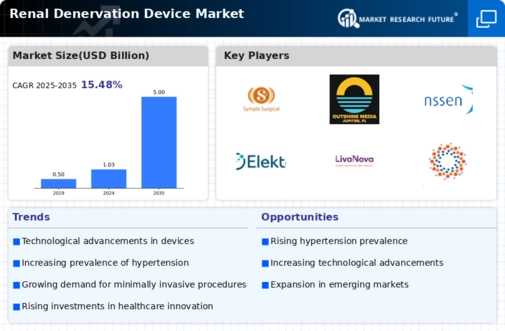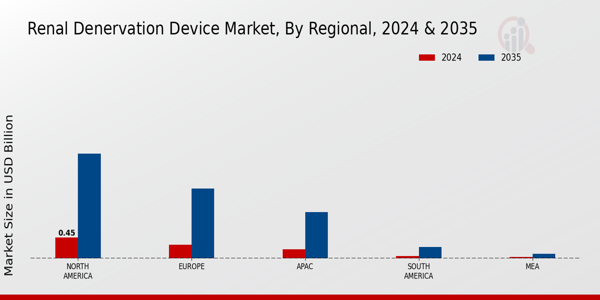Market Growth Projections
The Global Renal Denervation Device Market Industry is poised for substantial growth, with projections indicating a rise from 1.03 USD Billion in 2024 to 5 USD Billion by 2035. This growth reflects a compound annual growth rate of 15.45% from 2025 to 2035, highlighting the increasing demand for effective hypertension treatments. Factors contributing to this growth include rising hypertension prevalence, technological advancements, and enhanced healthcare infrastructure. As the market evolves, stakeholders are likely to focus on innovation and patient-centered care, ensuring that renal denervation devices remain at the forefront of hypertension management.
Regulatory Support and Approval
Regulatory support and approval for renal denervation devices significantly influence the Global Renal Denervation Device Market Industry. As regulatory bodies recognize the efficacy of these devices in treating resistant hypertension, they are streamlining the approval process. This support fosters innovation and encourages manufacturers to invest in research and development. The positive regulatory environment is likely to enhance market confidence, leading to increased adoption of renal denervation technologies. With the market expected to grow to 5 USD Billion by 2035, regulatory advancements will play a pivotal role in shaping its trajectory.
Rising Prevalence of Hypertension
The Global Renal Denervation Device Market Industry is experiencing growth due to the increasing prevalence of hypertension worldwide. As hypertension affects nearly 1.3 billion people globally, the demand for effective treatment options is rising. Renal denervation, a minimally invasive procedure, offers a novel approach to managing resistant hypertension. With the market projected to reach 1.03 USD Billion in 2024, healthcare providers are increasingly adopting these devices to improve patient outcomes. The growing awareness of hypertension's health implications further drives the need for renal denervation devices, positioning this market for substantial expansion.
Growing Awareness and Education Initiatives
The Global Renal Denervation Device Market Industry benefits from growing awareness and education initiatives aimed at both healthcare professionals and patients. Campaigns focused on hypertension management and the role of renal denervation in treatment are becoming more prevalent. These initiatives help demystify the procedure, encouraging more patients to seek treatment. As awareness increases, the adoption of renal denervation devices is likely to rise, contributing to market growth. The combination of education and improved patient outcomes is expected to drive the market towards its projected value of 1.03 USD Billion in 2024.
Technological Advancements in Device Design
Technological innovations play a crucial role in the Global Renal Denervation Device Market Industry. Recent advancements in device design, such as improved catheter technologies and energy delivery systems, enhance the efficacy and safety of renal denervation procedures. These innovations not only facilitate better patient experiences but also increase procedural success rates. As a result, healthcare providers are more inclined to adopt these advanced devices. The anticipated growth of the market to 5 USD Billion by 2035 underscores the importance of continuous technological development in meeting the evolving needs of patients and clinicians alike.
Increased Investment in Healthcare Infrastructure
Investment in healthcare infrastructure is a significant driver of the Global Renal Denervation Device Market Industry. Governments and private entities are increasingly allocating resources to enhance healthcare facilities and services, particularly in regions with high hypertension rates. This investment leads to improved access to advanced medical technologies, including renal denervation devices. As healthcare systems evolve, the integration of these devices into standard treatment protocols becomes more feasible. The projected compound annual growth rate of 15.45% from 2025 to 2035 indicates a robust market response to these infrastructural improvements, ultimately benefiting patient care.




















